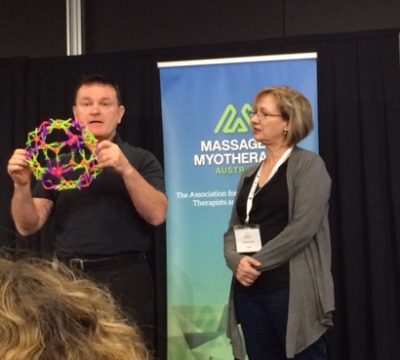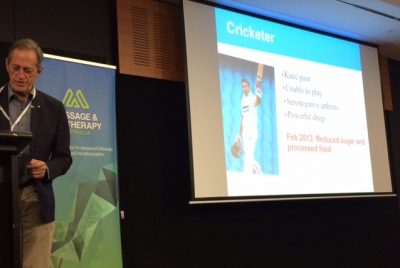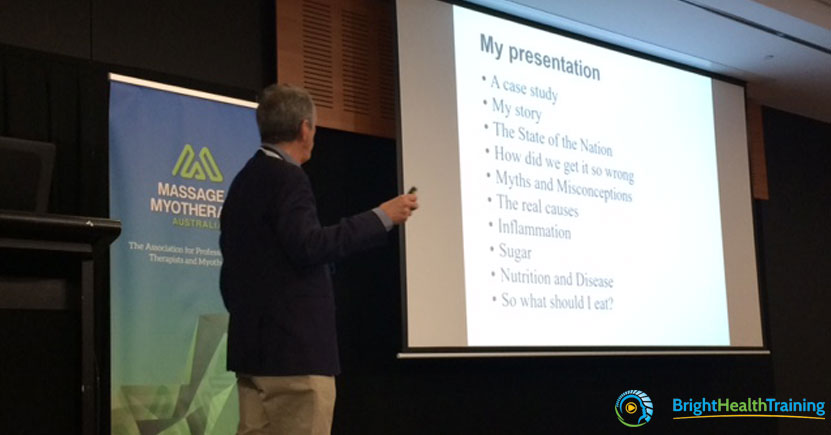
Did you go to the Massage & Myotherapy Australia Conference on the Gold Coast?
I was fortunate to attend the MAMA Conference and it was worth every cent, there was a great line-up including international speakers. Thought I’d share some of the highlights for those who didn’t make it…
Lisa Curry’s Story
We were treated to an opening talk from Lisa Curry, who gave an inspiring and motivating presentation. Lisa Curry is a huge advocate for massage treatment and she has sworn by its efficacy, having had regular massage during her entire Olympic career.
Lisa delivered a powerful message about determination and resilience. Many people know Lisa’s story as an Australian Olympic swimmer. In her humorous and entertaining style, she described the highs and lows of her career as a journey of hard training and determination. She was simply unstoppable, after semi-retiring to have a family, she had a yearning to come back to the sport and showed incredible courage to start training again with a one-month old baby in tow. “Do not underestimate the power people have” she said, relating to a client’s capacity to overcome pain or injury. Lisa defied all the odds by returning to Olympic swimming in her 30’s and didn’t listen to those who told her she was “too old.” Obviously not, as she went on to win more Olympic gold medals. “Resilience is the most powerful life journey.”
I found Lisa’s story to be both inspiring and moving and she brought a tear to many people’s eyes. Talking about her experiences she demonstrated incredible self-belief, it was hugely relatable and empowering especially for the women in the room.
John Sharkey – The Last Word on Anatomy?
John Sharkey is a clinical anatomist, a world class speaker and has been involved in body work for 30 years. John’s talk was both engaging and entertaining, this is a summary of his keynote presentation:
- The exciting prospect of self-development and how we are emerging as an industry.
- RICE – rest, ice, compression, elevation. ICE treatment has been disproved, it only delays recovery. Inflammation is the body’s natural healing process. All ice does is reduce/numb the pain temporarily.
- Evidence – science is now reinforcing the intuitive approach used by RMT’s for many years. It is a process of experience and observation, what works and what doesn’t.
- Fascia – is the most important tissue in the body. The concept of treating fascia has been around since the 1970’s.
- What is Fascia? Old definition and evidence was based on an architectural approach, an inaccurate description of the body being a solid structure with fixed joints. Not a body with moveable joints.
- Has science got it wrong with anatomical terms? John proposed that a new, more accurate anatomy is needed. eg the “spinal column” refers to a straight line structure. What happens when we bend forward or flex the spine?
- Humans should be explained by soft matter physics and we should begin to think of it this way. Let’s not be afraid of science, the research based evidence should be informing us.
- Continuity – there are no layers in the body’s tissues, everything is inter-connected eg. Bone, muscle, ligament, tendon, fascia, all in a continuum.
- Nature is the ultimate architect. If the approach or theory disagrees with nature, it is wrong.
- The language and terminology we use – not to send negative and confusing messages to clients. Classic example given was frozen shoulder. We could say “that will normally take 2 years to unfreeze.” Is that proven? What expectation is that setting up in the client’s mind?
- As practitioners, we should “focus on the positive aspects, empowering clients to be well.”
To find out more about John Sharkey click here. http://www.johnsharkeyevents.com/

Dr Peter Brukner’s Talk
Peter is a well-respected Sports Medicine Doctor, author, ex-medic for the Australian Cricket team and international speaker. I could rave all day about Peter’s presentation, it was brilliant.
Shoulder Pain Management
Peter talked about the medical paradigm and process for pain management, when a patient presents with an injury, this a Doctor’s approach:
- Prescribe medication/analgesics (generally “over prescribed”).
- Injection / cortizone (has a huge placebo effect but works in short-term).
- PRP (Platelet Rich Plasma) injections (trials show no better than placebo and are very expensive).
- Surgery – refer to a specialist for surgery/arthroscopy.
- Physio / Rehab exercises for the client.
- Soft tissue management (massage).
Peter highlighted it is interesting that our role in soft tissue treatment is rated so low considering the medical approaches, he admitted, are often so ineffective or short-term.
Peter demonstrated a shoulder assessment and made it really interactive, he got a few therapists up on stage to do some typical tests for the restricted shoulder. He then showed a few dry-needling techniques in trigger points around the shoulder girdle.
Peter Brukner’s Case Study – Michael Clarke
Captain of the Aussie cricket team Michael Clarke, tore his hamstring just before the last Cricket world cup. We saw Clarke’s MRI and Peter explained the pros and cons of getting MRI’s as they are expensive. In the case of minor injuries that we would see in the massage clinic, getting a picture of what’s going on inside doesn’t necessarily change the pain management for clients. In Michael’s case, being a professional cricket player it was a different ball game. He recovered from surgery with only 10 weeks to prepare for the world cup and in that extremely tight timeframe, was not only fit to qualify and play, he also went on to win the world cup. The rest of us “non-athletes” don’t have the luxury of working on our rehabilitation on a full-time basis. Interesting story and good example of when imaging can be helpful.
As a Doctor, Peter Brukner was extremely positive about the RMT’s role in pain management. He made the point that a GP doesn’t have the musculoskeletal training or skills of an RMT, so as therapists we should not have an “inferiority complex” and be confident that we do a great job in the area of chronic pain management.
Nutrition
The afternoon presentation covered nutrition, the trends and evidence linking diet and diseases. Interestingly, there is also a link between sugar and inflammation, nutrition and tendinopathy.
The “low fat” diet (theory) was fed to us by nutrition experts decades ago in the “nutrition pyramid.” Peter said this was misinformed and has resulted in many people now being “addicted to sugar.” Sugar and processed foods having the most impact on health. For more information on the healthy alternative Low Carb High Fat diet (LCHF) click here. https://lowcarbdownunder.com.au/dr-peter-brukner-and-lchf/
Bruce Stark – Orthobionomist
This was an interesting talk about working with the nervous system in the body for balance and self-regulation. “Nervous systems are designed to learn.”
Orthobionomy was developed in the 1970’s by a British Osteopath, Doctor Pauls. Basically it is PRT (positional release technique). PRT increases and decreases the sub-corrective reflexes in the body. The concept of PRT is a passive method of releasing tissue. Bruce highlighted that all sensory information is combined into sematosensory maps in our brain.
How to Use PRT?
- Muscle is placed in a relaxed passive position shortening the tissue to clear sensory message to the brain. This gives a sense of safety for the CNS.
- Use manual technique to create compression to the joint, without triggering.
- Hold static position 10-30 seconds.
- Re-check changes in tissue.
- Initially, take the joint through range of motion in a passive way without effort. This is to interrupt the tension pattern and reorganises the somatic map in the brain.
- In addition, active movement can be used when checking range of movement – triggers the pre-planning section of the brain.
Bruce also demonstrated proprioceptive feedback in the knee. By checking direction of movement, sliding the patella medial to lateral & superior to inferior movement. This is essentially joint mobilisation with the emphasis on remapping the cortical areas of the brain.
To find out more about Orthobionomy click here. http://www.brucestark.com.au/
Dr Neil Meigh
Dr Neil Meigh is a Physio, Myotherapist and lecturer. His workshop was entitled “A process approach with exercise and movement strategies for lower body.”
I cannot do Neil’s workshops justice as I only attended a brief session, but I was totally captivated by what I saw. It was an evidence based presentation that related well to massage and myotherapy treatments.
Neil cleverly recapped some of the key points from the other presenters, such as the importance of “resilience.” Also “Behaviour change” is essential for clients to adopt a more healthy lifestyle. He echoed John Sharkey’s point about the “spinal column” being an inaccurate anatomical description for the complex functional movement patterns of the human spine. “I am not a machine.”
Neil talked about the efficacy of the biopsychosocial model. Taking into account all of the lifestyle factors that contribute to the client’s presentation of symptoms and wellbeing. As soft tissue therapists we are not changing the structure or biomechanics. The body is individual and unique and does not comply with a structural model.
Neil made an excellent point “the body will heal itself innately.” This is vital to recognise especially when choosing appropriate language to use with clients. He described “incidentalomas” as unnecessary terms, or diagnosis through imaging/pathology that doesn’t necessarily change the management of pain.
Again backing up what Peter Bruckner said about MRI. “Treat the person not the diagnosis” Neil reiterated. His diagram showed “Recovery is a combined process of repair, adaptation and alleviation of symptoms.” Rehabilitation should focus on the client’s goals.
Evidence Based Research
Neil Meigh referenced many evidence-based resources and highly recommended finding these online:
– Lorimer Mosley’s research that movement is the key to pain management.
– Gregory Lehman’s Recovery Strategies for Pain Guidebooks.
The afternoon session was for practicing movement and exercises, everyone actively participating and rolling around on the floor. We tried the well known “Turkish get-up” exercise which requires full functional movement of the whole body. We also practiced a number of stability and body weight exercises that were both fun and surprisingly challenging for many of us therapists!
For me personally Neil nailed it with a perfect combination of talking and doing, I liked that we had to get up and get moving in a practical sense. Thank goodness he didn’t get out the kettlebells (or I might have skipped that part).
To access some free resources on Neil’s website click here. http://kettlebell.physio/
All wrapped up for another year
There were a few other workshops going on as well, but I’ve only written about the ones I attended. The conference ended, with Andrew the President of Massage and Myotherapy Australia summing up the weekend’s highlights. Even though the weekend was hugely attended by Queenslanders, there was a great vibe and all I heard was very positive feedback. Next year the conference will be in CANBERRA!

